Brown Spot on Mushroom Caps: Symptoms, Prevention, and Treatment Guide
What is Bacterial Blotch disease
Bacterial Blotch, also known as Brown Spot or Brown Blotch, stands as the most prevalent bacterial disease affecting both commercially cultivated and home-grown mushrooms. This disease has far-reaching economic implications for mushroom farms worldwide, primarily due to its impact on quality of edible mushrooms, though it poses no health risks to humans.
This type of contamination has less dramatic impact to cultivators who grow magic mushrooms in bags, fruiting chambers or grow tents, but this annoying disease has happened to all growers from time to time.
Bacterial Blotch can be caused by various pathogens within the Pseudomonas genus, characterized as aerobic, Gram-negative soil bacteria. These motile, non-spore forming pathogens include:
Brown Spot, Bacterial Blotch, and Brown Blotch: Caused by Pseudomonas tolaasii, which is the most common cause of this type of contamination.
Ginger Blotch: Attributed to the P. fluorescens species group, collectively referred to as Pseudomonas 'gingeri'.
Brown Speckling or Pitting on Mushroom Caps: Resulting from Pseudomonas costantinii.
Mild Yellow Blotch Disease on Oyster Mushroom Species: Linked to Pseudomonas reactans and Pseudomonas agarici.
Scientific classification
Domain: Bacteria
Phylum: Pseudomonadota
Class: Pseudomonadota (synonym Proteobacteria)
Order: Pseudomonadales
Family: Pseudomonadaceae
Genus: Pseudomonas
Species: P. tolaasii, P. agarici, P. costantinii etc.
🔮 Pseudomonas bacterium, and Pseudomonas tolaasii particularly, is a fluorescent bacterium (P. fluorescens group), which is known for its ability to produce a fluorescent pigment. The production of this pigment is one of the identifying characteristics of many Pseudomonas species (but not for all!) used in the laboratory for differentiating it from other bacteria. This fluorescence can be observed under UV light at 365 nm, which causes the bacterial colonies to emit a bluish-green or greenish-yellow glow
Symptoms of Bacterial Blotch contamination on mushrooms
Under optimal conditions, the population of P. tolaasii experiences rapid growth, accompanied by increased production of the toxin known as tolaasin.
Tolaasin disrupts the plasma membranes of mushroom cells, leading to their eventual collapse. This impact isn't confined to the mushroom's surface; when secreted, tolaasin can infiltrate deeper into the hypha tissues within the mushroom. Furthermore, tolaasin acts as an effective biosurfactant, reducing the surface tension of water. Lower surface tension allows water to spread over a larger area, facilitating the colonization of fresh areas on the mushroom cap by P. tolaasii.
The contamination process unfolds as follows:
P. tolaasii is deposited on the mushroom's surface -> senses the mushroom's presence -> moves towards it -> then releases tolaasin to compromise the plasma membrane of mushroom cells -> and access the nutrients within.
Initially, the affected areas exhibit a pale yellow hue, which later deepens to golden yellow or even a deep brown, eventually forming sunken lesions.
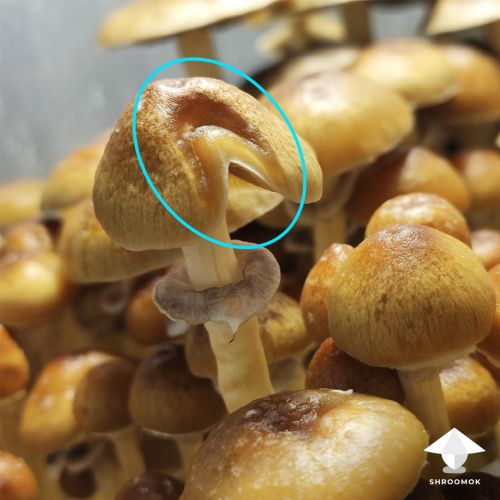
Typically these brown spots are wet and slightly slimy or can have brown dry speckles and pits on mushroom caps
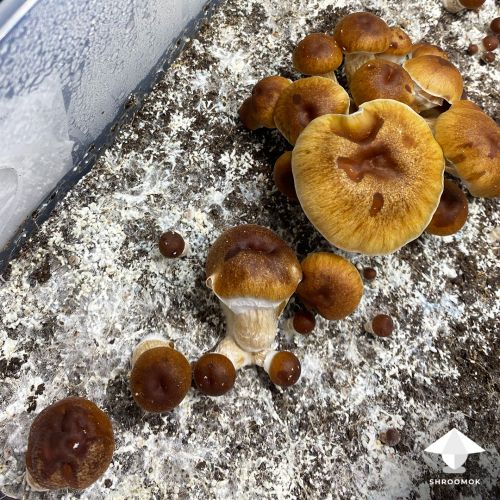
As the blotch disease progresses, these spots transform into dark brown lesions.

Yellow-brown or black blotches become evident at or near the edges of mushroom caps, at the points where two mushroom caps make contact, or within a cluster where mushrooms touch each other.
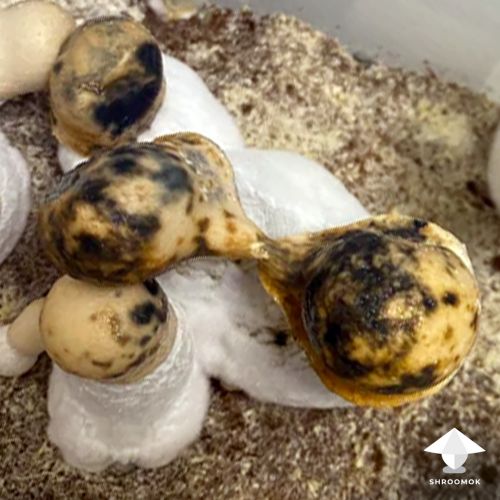
In the advanced stages of blotch development, the affected areas turn black, indicating the bacterial decomposition of mushroom tissue. In this case (see photo below) most of pins were affected and they stalled. There are mild brown and black blotch on mature shrooms.
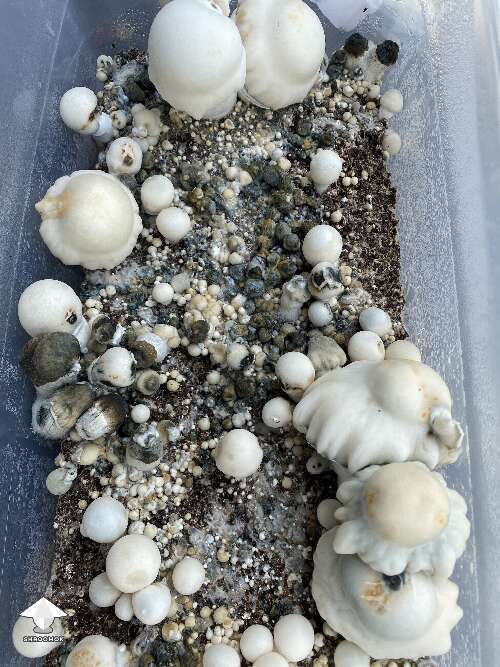
Main Causes of Bacterial Brown Spot in Mushroom Cultivation
The primary sources of the blotch pathogen responsible for Bacterial Brown Spot in mushroom cultivation include bulk substrate, casing substrate, airborne dust, clothing, tools, equipment, insects.
These bacteria is likely present in most bulk and casing substrates, even after pasteurization. Healthy mushrooms may carry a small population of this bacteria on their caps, but this alone does not necessarily lead to bacterial blotch disease. The key factor seems to be the size of the bacterial population on the cap, rather than within the casing.
All bacteria need water to thrive, reproduce, and colonize. Water is a crucial factor for the growth and spreading of most bacteria, including Pseudomonas tolaasii species in mushroom cultivation. Bacterial blotch disease typically occurs when water droplets remain on mushroom caps and stems for an extended period, usually between 4 to 8 hours or longer after the application of water. Excessive misting and water splashes can cause the bacterial population to increase and spread.
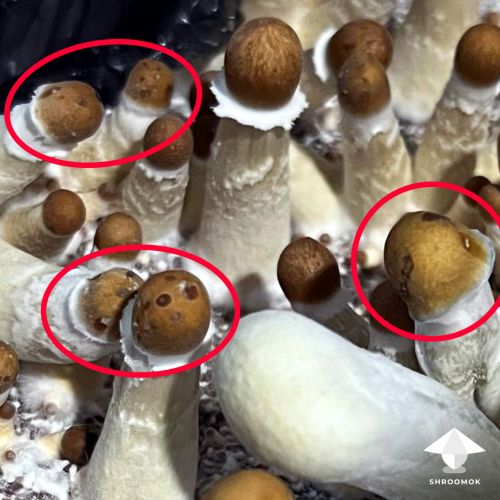
This situation often arises due to the following reasons:
Direct and Excessive Misting: Misting on mushroom fruit bodies directly and too much. Using a spray bottle with large water droplets. Using fogger for too long and lack of fresh air exchange.
Water Pools: The top layer of the substrate retains moisture for an extended period after misting or rehydration (soaking mushroom cake in water). By the way, dry top layer absorbs water poorly and more often such cake has water pools on top layer.
Fluctuations in Temperature and Humidity: Changes in temperature or relative humidity can alter evaporation rates and condensation, creating favorable conditions for bacterial pathogens.
Condensation on fruits: Condensation can form on mushroom caps and stems, either due to spraying or temperature fluctuations.
Additionally, condensation water drops falling from the lid of the fruiting chamber directly onto the mushrooms can contribute to the development of bacterial blotch disease.
How to Prevent Bacterial Blotch Contamination
Preventing Bacterial Blotch contamination is essential for successful mushroom cultivation. Here are some effective measures to consider:
Misting Technique: Instead of spraying water directly onto the mushrooms, mist the walls of your tub or fruiting chamber. This approach helps maintain optimal humidity without saturating the mushroom caps.
Use of Ultra Fine Mist or Humidifier with Humidity Controller: Use an Ultra Fine Mist Spray Bottle ($8.99) for manual misting. Or invest in simple equipment like a Fogger/Humidifier ($59.99) to ensure that water droplets are finely dispersed and accurate Humidity Controller ($30.09) to maintain stable humidity level automatically. These help to reduce the risk of excess moisture on mushroom surfaces.
Manage Water Pools: After misting or rehydrating the mushroom cake to initiate the next flush, ensure that any pooled water disappears within 12-16 hours. If it persists, don't mist the fruiting chamber and lower the relative humidity to 80-85% until the top layer of the substrate is dry.
Casing Layer: Soft, airy casing layer on the mushroom cake is beneficial. This layer enhances water absorption and creates an ideal microclimate for mushroom growth.
WD-40 trick
Address Condensation Issues. If you have temperature fluctuations in your growing environment (typically during the cold season) condensation on the lid of the fruiting chamber can lead to water droplets falling onto the mushrooms. To deal with this problem, I'd like to share a useful technique from my gardening (greenhouse) experience, that also effective for mushroom fruiting chamber and mushroom grow tent. Let's call it the "WD-40 trick":
Take WD-40 ($14.99) and spray it 5 times into 1 quart (1 liter) of water.
Shake well and fill a spray bottle with this solution.
Wipe the lid of your fruiting chamber (e.g., GrowBox, MonoTub, shoebox) to ensure it's completely dry.
Spray the WD-40 solution on the lid of your fruiting chamber.
Wipe the lid with a cloth or paper towel, moving from side to side.
This method helps prevent condensation water drops from forming on the lid and falling onto your mushrooms. Excess water will flow down the chamber walls, reducing the risk of bacterial blotch contamination on the caps.
WD-40 doesn't come into contact with the mushrooms and is not harmful to them
Compare results BEFORE/AFTER on the photos below.
Before using WD-40 method. The condensation droplets appear large and are prone to falling off the surface easily. This can lead to unwanted moisture on mushroom caps, potentially increasing the risk of bacterial blotch contamination.

After using the WD-40 solution. Remarkable change in condensation patterns. Water droplets are now notably smaller and remain adhered to the lid's surface. Excess water is less likely to fall onto the mushrooms below, decreasing the risk of bacterial blotch disease on their caps.
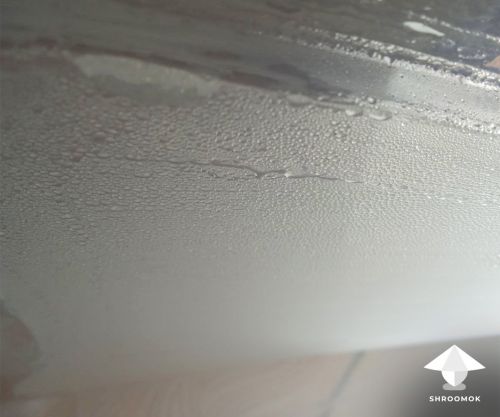
Bacterial Blotch Treatment
In 1972, Nairand Fahy put forward a biological control approach for managing the Pseudomonas tolaasii species. He illustrated that the introduction of Pseudomonas fluorescens, a natural antagonist to P. tolaasii, effectively diminished the incidence of blotch without impacting the yield of Agaricus brunescens. Nonetheless, some experts suggesting that P. fluorescens might be considered a variant of P. tolaasii. As a result, are cautious in approving its use.
Brown mushrooms exhibit a natural resistance to brown blotch disease in contrast to their white counterparts. However, the specific gene responsible for this resistance remains unidentified at this time.
Melanins represent a defence system in all organisms as well as a resistance mechanism to stress. In fungi, melanins also appear to be important in conferring resistance to microbial attacks. They can also have an antibiotic effect against antagonist organisms. The main role of fungal melanins is probably to provide protection against hydrolytic enzymes, such as glucanases and chitinases, thus preventing cell wall lysis. Biochemical and physiological aspects of brown blotch disease of Agaricus bisporus
Today, the most common treatments for Bacterial Blotch include:
Isolation (Pick and Toss): Remove the most affected mushroom bodies to prevent the spread of bacteria to nearby mushrooms.
Chlorinated Water (150-250 ppm concentrate): This weak solution is not harmful to mushrooms but is effective against Bacterial Blotch pathogens and also Mycogone Wet Bubble disease
How to prepare 150-250 ppm Chlorinated Water?
Dissolve the bleach (Sodium Hypochlorite - NaOCl) in 1 liter of water according to these ratios:
NaOCl 5.25% (Amazon) - add 3.0-5.0 ml per 1L of water
NaOCl 6.0% (Amazon) - add 2.6-4.4 ml per 1L of water
NaOCl 7.5% (Amazon) - add 2.1-3.5 ml per 1L of water
NaOCl 12.5% (Amazon) - add 1.3-2.1 ml per 1L of water
Fill a spray bottle with the solution.
Open the lid of the fruiting chamber and try to dry the water drops on the mushrooms, at least the biggest and the most visible. You can gently use a fan or leave the tub open for 30-40 minutes to allow the water droplets to evaporate.
💡 Pro Tip: Chlorinated water is an effective disinfectant, but it works best when the mushrooms are dry. If the mushrooms are wet, the Pseudomonas bacteria can reproduce faster than the disinfectant can kill them. Therefore, sodium hypochlorite (NaOCl) solution is sometimes ineffective on wet mushrooms.
Lightly mist the mushrooms once a day for 3 days; or make 3 treatments with a 12-hour break between each misting.
❗️Important: Use the bleach solution when you see signs of Bacterial Blotch contamination. Don't use bleach solution as a prevention measure. It is for treatment purposes only!
Keep relative humidity 80-85% during treatment session and for the few days.
Monitor the progress. In some cases, a single treatment may yield positive results.
If the blotches are treated at an early stage, right after the first signs of brown spots appear, they may disappear before the mushrooms mature. After treatment or in very dry conditions following the appearance of blotch, the caps of the mushrooms may crack radially as they expand. Such shrooms with cracks are totally normal for harvesting!
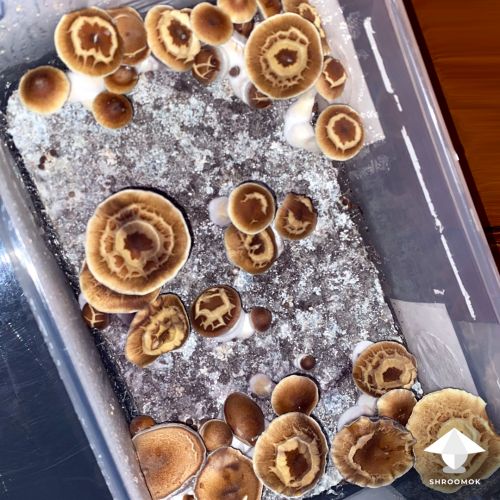
Is it safe to consume mushrooms with Bacterial Brown Spot
There are over 150-200 validly described species within the Pseudomonas genus. The one known to cause infections in humans is called Pseudomonas aeruginosa. However, only a few of Pseudomonas species affect mushrooms.
The Pseudomonas species that cause bacterial blotch on mushrooms, including P. tolaasii, P. costantinii, P. reactans, P. agarici, and P. 'gingeri', are not toxic and do not pose any threat to human health.
Once you dry mushrooms well, they'll be fine for sure. Bacterial cells can't survive without water. Hence, mushrooms affected by bacterial blotch are safe to take after being dehydrated at a 120°F (50°C).
You can also trim away the affected parts before drying your shrooms.
If your mushrooms are not looking their best or excessively slimy, don't dry and take them. They might have an unpleasant odor and turn into a mushy mess in dehydrator. It's perfectly fine to bid farewell and send them off to the trash bin.
Afterwords
Check out more photo examples of different contaminations and cultivation issues in 📸 Growing Problems photo gallery
Join Shroomok Community on Discord and Reddit for questions and sharing experience.
You can also leave your comments on this page below ⬇️
If you find this guide helpful, please support me with cup of coffee on ☕️ buymeacoffee
Have a happy growing and healthy shrooms!
Peace, Shroomok ❤️


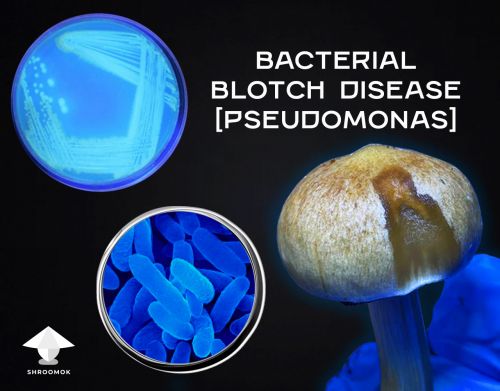
Comments
Add comment